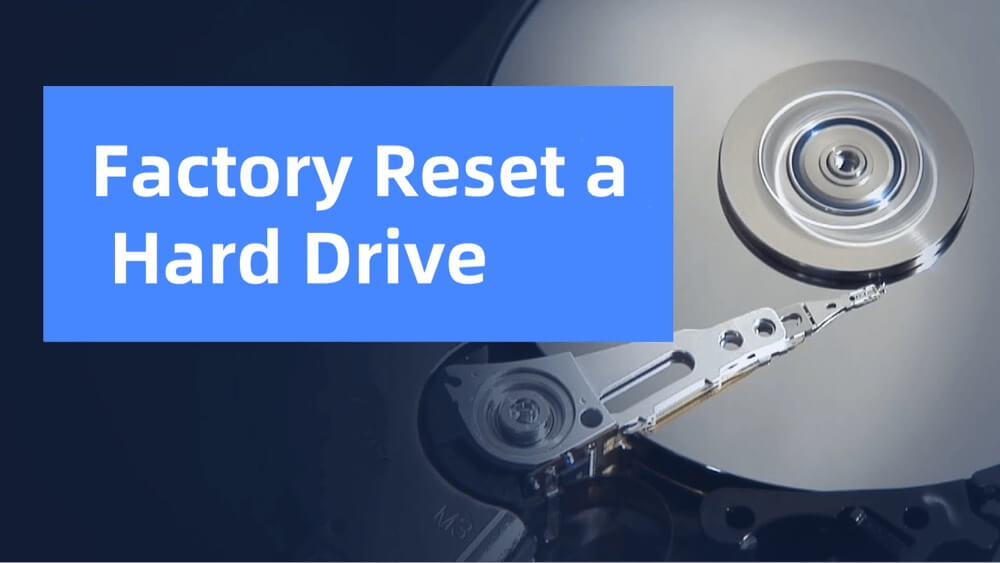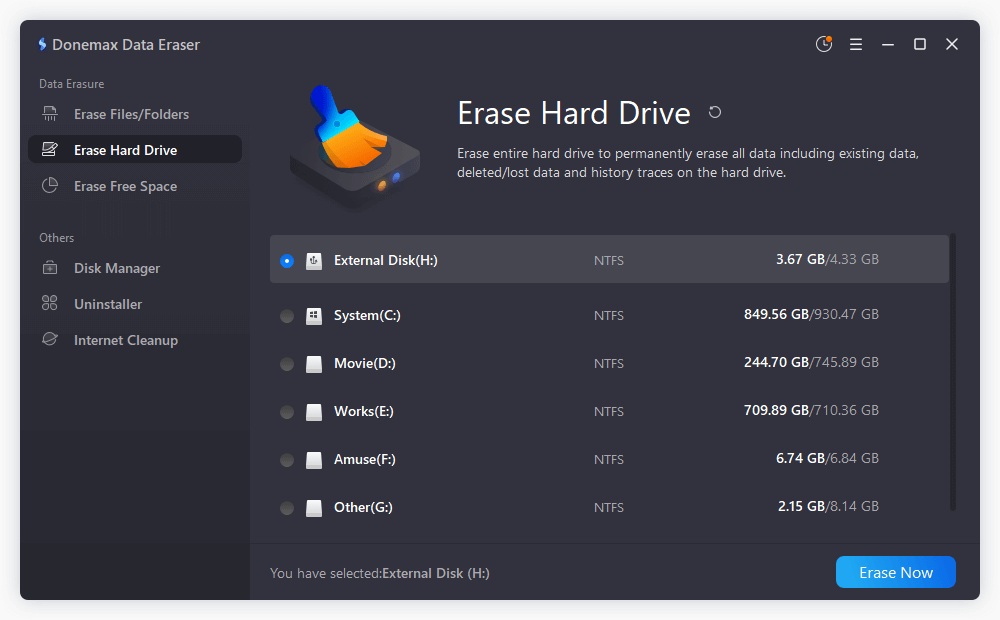Before we start: If you will sell, donate or dispose of your old hard drive, you'd better reset the hard drive to its factory settings. Donemax Data Eraser is a powerful disk wipe tool. It can securely and permanently wipe all data from the hard drive, ensure no data is recoverable. It is 100% safe and won't cause any physical damage. If you want to factory reset a HDD, SSD or external storage device, just try this disk wipe tool.
PAGE CONTENT:
Factory resetting a hard drive is a crucial process, whether you're preparing a computer for resale, removing persistent malware, fixing performance issues, or simply wanting to start fresh. But what exactly does it mean to reset a hard drive? Is it the same as formatting or wiping it? And how do you do it securely?
In this comprehensive guide, we'll walk you through everything you need to know about resetting a hard drive - from understanding key terminology to step-by-step instructions on different operating systems.

What Does "Reset a Hard Drive" Mean?
"Resetting" a hard drive can mean different things depending on the context. For some users, it simply means reformatting the drive to erase all data. For others, it involves a deeper wipe to ensure data is unrecoverable.
In general, resetting a hard drive refers to the process of restoring it to a clean, usable state by removing all data and optionally reinstalling the operating system.
Reset vs. Format vs. Wipe: What's the Difference?
Before proceeding, it's important to clarify the terms often used interchangeably:
1. Reset
- Usually refers to a system-level operation such as resetting a Windows or macOS computer to factory settings.
- May keep the OS intact but remove user data and apps.
2. Format
- A process of preparing a storage device for use by erasing the existing file system and creating a new one.
- Data may still be recoverable using recovery software.
3. Wipe
- A secure erase of the hard drive that overwrites the data, making it unrecoverable.
- Necessary if you're disposing of, selling, or giving away a drive.
Each method serves different purposes, and choosing the right one depends on your goals - whether it's performance improvement or data privacy.
Preparation Before Resetting a Hard Drive
Resetting a hard drive will erase data, so it's vital to prepare carefully:
1. Back Up Important Data
- Use an external hard drive or cloud storage.
- Make sure you’ve backed up documents, photos, app settings, and emails.
2. Deactivate Software Licenses
- Applications like Adobe Creative Cloud or Microsoft Office may require deactivation before reinstalling.
3. Disconnect External Devices
- To avoid confusion or accidental formatting, unplug all USB drives or external storage devices.
4. Ensure Stable Power
- For laptops, connect to a charger. For desktops, use a UPS if possible.
How to Reset a Hard Drive (Including Internal Disk) on Windows?
Windows offers several options for resetting a hard drive. You can either reset the entire system or manually format drives.
Option 1: Use the Reset this PC Feature
This method is ideal if you're resetting the main drive with Windows installed.
Steps:
- Go to Settings > System > Recovery.
![Factory resetting a hard drive]()
- Under Recovery options, click Reset this PC.
![Factory resetting a hard drive]()
- Choose:
- Keep my files: Retains personal files but removes apps and settings.
- Remove everything: Fully resets the PC.
![Factory resetting a hard drive]()
- Choose Local reinstall or Cloud download.
![Factory resetting a hard drive]()
- Follow the prompts to complete the process.
💡 Tip: Choose "Remove everything" and enable the "Clean data" option for a more secure reset.
Option 2: Use Disk Management to Format the Drive
Ideal for secondary drives.
Steps:
- Press Win + X > Disk Management.
![Factory resetting a hard drive]()
- Right-click the target drive > Format.
![Factory resetting a hard drive]()
- Choose file system (NTFS recommended), allocation size, and name the volume.
- Check Perform a quick format (or uncheck for a full format).
![Factory resetting a hard drive]()
- Click OK.
How to Reset a Hard Drive on macOS?
Mac users can reset their drives using Disk Utility or through macOS Recovery.
Option 1: Use Disk Utility to Erase the Hard Drive
Best for external drives or additional internal partitions.
Steps:
- Open Disk Utility (Finder > Applications > Utilities).
![Factory resetting a hard drive]()
- Select the target drive > Click Erase.
![Factory resetting a hard drive]()
- Choose a format (APFS for SSDs, Mac OS Extended for HDDs).
- Name the drive and click Erase.
![Factory resetting a hard drive]()
Option 2: macOS Recovery Mode to Erase System Disk
Ideal for resetting the main system drive.
Steps:
- To enter Recovery Mode, restart your Mac and press and hold Command + R. If you are using a Mac with Apple silicon, press and hold Power button. Then choose Options, click Continue.
![Factory resetting a hard drive]()
- Choose Disk Utility, select the main drive, click Erase.
![Factory resetting a hard drive]()
- After erasing, close Disk Utility.
- Select Reinstall macOS and follow on-screen instructions.
![Factory resetting a hard drive]()
Tips for Resetting an External Hard Drive:
External drives can be reset on either Windows or macOS.
On Windows:
- Plug in the external hard drive.
- Open Disk Management.
- Right-click the drive > Format or Delete Volume > Create new volume.
- Choose exFAT or NTFS as the file system.
On macOS:
- Open Disk Utility.
- Select the external drive > Click Erase.
- Choose format (exFAT for cross-platform compatibility).
- Click Erase.
💡 Note: After factory resetting the hard drive on Windows or macOS, the formatted or lost data is still recoverable. Data recovery software can easily recover deleted, formatted or inaccessible data from local disk or external storage device.
Secure Methods to Reset a Hard Drive [Data Unrecoverable]
If your goal is to ensure that data on the drive is permanently deleted and cannot be recovered - especially when donating, recycling, or selling a computer - standard formatting won't cut it. Formatting removes the file system references, but the actual data may still be retrievable using recovery software. To truly reset a hard drive securely, you must go beyond basic formatting and use secure erase methods.
1. Why Secure Erase Matters?
When you delete a file or format a drive, the data isn’t really gone. It’s just marked as free space, and until that space is overwritten by new data, the old data can still be recovered using specialized tools. This poses a risk for sensitive data like:
- Banking and financial records
- Personal photos and documents
- Login credentials and saved passwords
- Business or confidential files
In such cases, a secure reset ensures complete, unrecoverable erasure.
2. Built-in Tools for Secure Erase
BitLocker (Windows):
If your Windows system uses BitLocker encryption, you can enable it first and then format the drive. This adds a layer of protection, because even if someone tries to recover the data later, it will be encrypted and unreadable without the recovery key.
Steps:
- Enable BitLocker from Control Panel > System and Security > BitLocker Drive Encryption.
![Factory resetting a hard drive]()
- Once encryption is complete, reset or format the drive normally.
![Factory resetting a hard drive]()
FileVault (macOS):
On Macs, FileVault performs a similar function. If FileVault is enabled, your drive is encrypted using XTS-AES-128 encryption. Even if someone tries to recover data after formatting, the encryption keeps it secure.
Steps:
- Go to System Settings > Privacy & Security > FileVault.
![Factory resetting a hard drive]()
- Turn on FileVault before wiping the drive.
3. Use Secure Erase Tools (Third-Party)
Third-party tools go further by overwriting your drive with patterns of data that make recovery practically impossible.
Top 3 Disk Wipe Software for Factory Resetting a Hard Drive:
| NO. | Disk Wipe Software | Pros | Cons |
|---|---|---|---|
| 1 | Donemax Data Eraser |
|
|
| 2 | DBAN |
|
|
| 3 | Blancco Drive Eraser |
|
|
Steps to factory reset a HDD, SSD or storage device with Donemax Data Eraser:
Step 1. Download and install Donemax Data Eraser on your computer.
Donemax Data Eraser
- Securely and permanently shred files from any hard drive.
- Wipe a hard drive to permanently erase all data from the drive.
- Wipe free disk space to securely wipe deleted/formatted/lost data.
Step 2. Open Donemax Data Eraser, then choose the Erase Hard Drive mode. Select the drive you want to reset, then click on Erase Now button.

It will securely and permanently erase all data (including existing data, deleted/formatted/lost data, hidden data, etc) from the hard drive.
4. Secure Erase for SSDs
SSDs manage data differently from HDDs due to wear-leveling and block-based architecture. Standard overwrite methods are less effective. For SSDs, it's best to use manufacturer-specific tools that issue a Secure Erase command to the drive's firmware.
Examples:
- Samsung Magician: For Samsung SSDs, includes a Secure Erase feature.
- Crucial Storage Executive: For Crucial drives, performs native SSD wipe.
- Intel SSD Toolbox: For Intel SSDs, securely erases the drive with firmware-level commands.
These tools perform a zero-fill or crypto-erase, depending on drive type. In crypto-erase, the encryption key is deleted, rendering all data unreadable instantly - a fast and effective method.
5. Overwriting with Multiple Passes
For extra caution, some users choose to overwrite data multiple times. While one pass is often sufficient for most users, higher security standards (e.g., Department of Defense) suggest 3–7 passes.
Common Methods:
- One-pass Zero Fill: Writes zeros to every bit.
- DoD 5220.22-M: 3-pass wipe with specific patterns (zero, one, random).
- Gutmann Method: 35-pass wipe - considered overkill for modern drives.
⚠️ Warning: Multiple overwrites significantly reduce SSD lifespan. Not recommended unless you are using an HDD or it's an absolute requirement.
6. Secure Delete Individual Files or Free Space
If you don't want to reset the whole drive but need to securely delete specific files:
- Windows: Use Eraser to securely delete files.
- macOS: Terminal commands like srm (in older macOS versions) can securely remove files.
- Linux: Use shred or wipe commands for secure file deletion.
You can also wipe free space to ensure deleted files can't be recovered:
- Windows: CCleaner includes a free space wipe feature.
- macOS: Use third-party tools like Donemax Data Eraser for Mac.
What to Do After Factory Resetting a Hard Drive?
Once you've successfully reset your hard drive, it's time to set it up again:
1. Repartition and Format (if necessary)
- For new or wiped drives, you may need to create partitions and assign drive letters.
2. Reinstall Operating System
- Use Windows Installation Media or macOS Recovery to reinstall the OS.
3. Restore Backed-Up Data
- Move files back from your cloud or external storage.
4. Reinstall Software
- Install essential applications and reactivate licenses.
5. Enable Security Measures
- Turn on BitLocker (Windows) or FileVault (macOS).
- Install antivirus software and enable firewalls.
Common Issues and Troubleshooting
Drive Doesn't Show Up
- Check BIOS/UEFI to ensure the drive is recognized.
- Update storage drivers.
- Try connecting to another port or system.
Format Failed
- Use a third-party tool like Donemax Data Eraser or GParted.
- Try a low-level format.
Accidentally Reset the Wrong Drive
- Stop using the drive immediately.
- Use recovery software like Donemax Data Recovery.
Stuck During OS Reinstallation
- Check installation media for corruption.
- Recreate bootable USB from official sources.
Conclusion
Resetting a hard drive isn't just about clicking "Format." It involves understanding your goals - whether you're clearing space, fixing errors, or protecting your privacy - and choosing the right method accordingly.
For everyday users, system reset options in Windows or macOS offer a quick fix. For more advanced users, tools like Donemax Data Eraser, DBAN, and Disk Utility provide deeper control. And if security is a concern, secure erase techniques are a must.
No matter which route you take, always remember: back up your data before proceeding.
By complying the steps in this article, you can confidently reset any hard drive and start fresh - whether for performance, security, or peace of mind.


Donemax Data Eraser
One of the best data erasure programs for permanently erase data from PC, Mac, HDD, SSD, USB drive, digital camera and other devices. Once the data is erased, it is lost for good, cannot be recovered by any method.
Related Articles
- Jun 09, 2025About 'Reset This PC': How to Use 'Reset This PC' to Factory Reset a Computer
- May 23, 2025Format SD Card to NTFS on Windows 11 / 10 / 8 / 7
- Feb 05, 2024How to Wipe A Lexar Portable SSD?
- May 06, 2025How to Bypass Recycle Bin When Deleting Files on Windows PC?
- Jan 25, 2024How to Wipe Kingston HDD/SSD to Makes Data Unrecoverable?
- Feb 02, 2024What Is Diskpart Clean and How to Use It to Wipe Data?

Steven
Steven has been a senior writer & editor of Donemax software since 2020. He's a super nerd and can't imagine the life without a computer. Over 6 years of experience of writing technical solutions and software tesing, he is passionate about providing solutions and tips for Windows and Mac users.

Gerhard Chou
In order to effectively solve the problems for our customers, every article and troubleshooting solution published on our website has been strictly tested and practiced. Our editors love researching and using computers and testing software, and are willing to help computer users with their problems
















